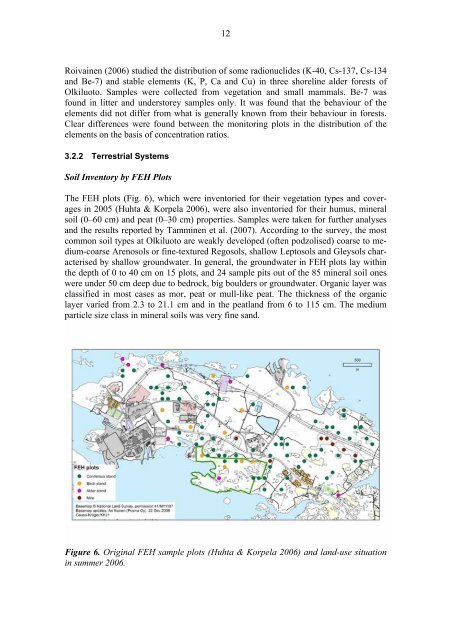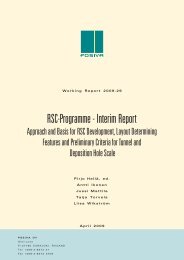Results of Monitoring at Olkiluoto in 2006 - Environment (pdf) - Posiva
Results of Monitoring at Olkiluoto in 2006 - Environment (pdf) - Posiva
Results of Monitoring at Olkiluoto in 2006 - Environment (pdf) - Posiva
Create successful ePaper yourself
Turn your PDF publications into a flip-book with our unique Google optimized e-Paper software.
12Roiva<strong>in</strong>en (<strong>2006</strong>) studied the distribution <strong>of</strong> some radionuclides (K-40, Cs-137, Cs-134and Be-7) and stable elements (K, P, Ca and Cu) <strong>in</strong> three shorel<strong>in</strong>e alder forests <strong>of</strong><strong>Olkiluoto</strong>. Samples were collected from veget<strong>at</strong>ion and small mammals. Be-7 wasfound <strong>in</strong> litter and understorey samples only. It was found th<strong>at</strong> the behaviour <strong>of</strong> theelements did not differ from wh<strong>at</strong> is generally known from their behaviour <strong>in</strong> forests.Clear differences were found between the monitor<strong>in</strong>g plots <strong>in</strong> the distribution <strong>of</strong> theelements on the basis <strong>of</strong> concentr<strong>at</strong>ion r<strong>at</strong>ios.3.2.2 Terrestrial SystemsSoil Inventory by FEH PlotsThe FEH plots (Fig. 6), which were <strong>in</strong>ventoried for their veget<strong>at</strong>ion types and coverages<strong>in</strong> 2005 (Huhta & Korpela <strong>2006</strong>), were also <strong>in</strong>ventoried for their humus, m<strong>in</strong>eralsoil (0–60 cm) and pe<strong>at</strong> (0–30 cm) properties. Samples were taken for further analysesand the results reported by Tamm<strong>in</strong>en et al. (2007). Accord<strong>in</strong>g to the survey, the mostcommon soil types <strong>at</strong> <strong>Olkiluoto</strong> are weakly developed (<strong>of</strong>ten podzolised) coarse to medium-coarseArenosols or f<strong>in</strong>e-textured Regosols, shallow Leptosols and Gleysols characterisedby shallow groundw<strong>at</strong>er. In general, the groundw<strong>at</strong>er <strong>in</strong> FEH plots lay with<strong>in</strong>the depth <strong>of</strong> 0 to 40 cm on 15 plots, and 24 sample pits out <strong>of</strong> the 85 m<strong>in</strong>eral soil oneswere under 50 cm deep due to bedrock, big boulders or groundw<strong>at</strong>er. Organic layer wasclassified <strong>in</strong> most cases as mor, pe<strong>at</strong> or mull-like pe<strong>at</strong>. The thickness <strong>of</strong> the organiclayer varied from 2.3 to 21.1 cm and <strong>in</strong> the pe<strong>at</strong>land from 6 to 115 cm. The mediumparticle size class <strong>in</strong> m<strong>in</strong>eral soils was very f<strong>in</strong>e sand.Figure 6. Orig<strong>in</strong>al FEH sample plots (Huhta & Korpela <strong>2006</strong>) and land-use situ<strong>at</strong>ion<strong>in</strong> summer <strong>2006</strong>.
















